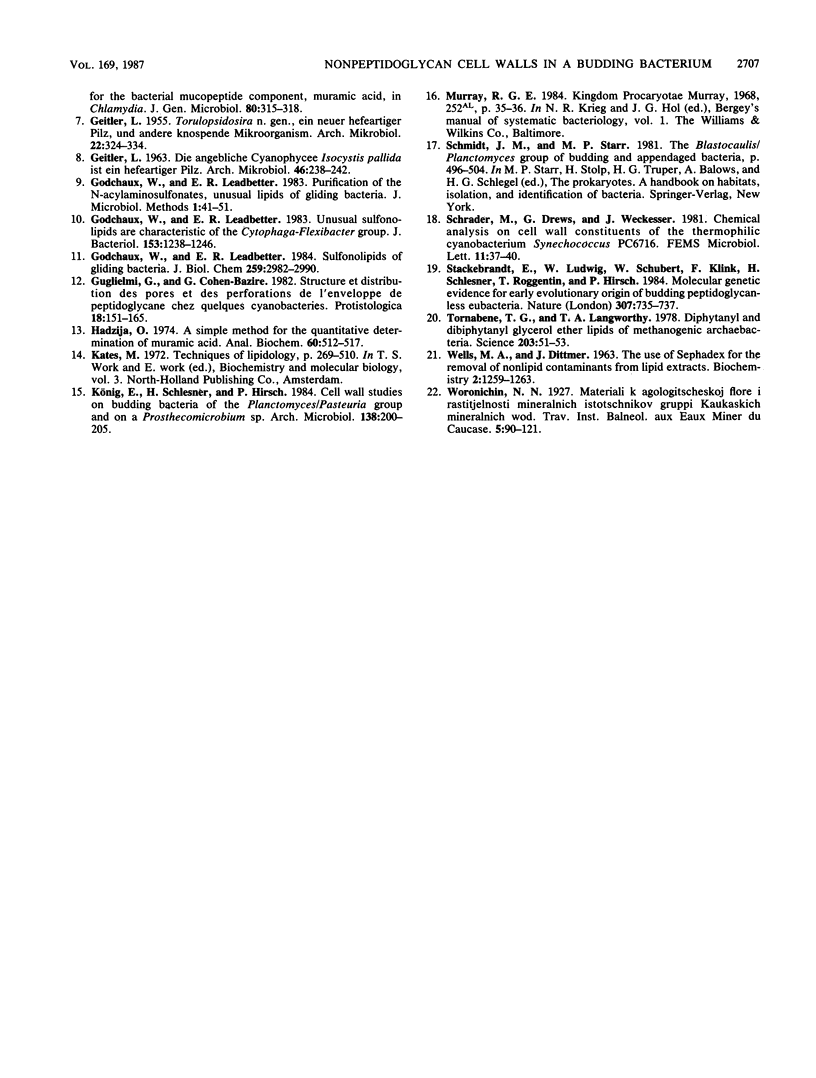Abstract
Isosphaera pallida is an unusual gliding, budding eubacterium recently isolated from North American hot springs. Electron micrographs of ultrathin sections revealed a cell wall atypical of eubacteria: two electrondense layers separated by an electron-transparent layer, with no evident peptidoglycan layer. Growth was not inhibited by penicillin. Cell walls were isolated from sheared cells by velocity sedimentation. The rigid-layer fraction, prepared from cell walls by treatment with boiling 10% sodium dodecyl sulfate, was hydrolyzed and chemically analyzed for muramic acid. This essential component of peptidoglycan was absent. Amino acid analysis demonstrated a proteinaceous wall structure. Pitlike surface structures seen in negatively stained whole cells and thin sections were correlated with periodically spaced perforations of the rigid sacculus. An analysis of the lipid composition of I. pallida revealed typical ester-linked lipids with unbranched fatty acids, in contrast to the isoprenyl ether-linked lipids of archaebacteria, which also have proteinaceous cell walls. Capnoids, unusual sulfonolipids which are present in gliding bacteria of the Cytophaga-Flexibacter group, were absent.
Full text
PDF





Images in this article
Selected References
These references are in PubMed. This may not be the complete list of references from this article.
- BLIGH E. G., DYER W. J. A rapid method of total lipid extraction and purification. Can J Biochem Physiol. 1959 Aug;37(8):911–917. doi: 10.1139/o59-099. [DOI] [PubMed] [Google Scholar]
- Barbour A. G., Amano K., Hackstadt T., Perry L., Caldwell H. D. Chlamydia trachomatis has penicillin-binding proteins but not detectable muramic acid. J Bacteriol. 1982 Jul;151(1):420–428. doi: 10.1128/jb.151.1.420-428.1982. [DOI] [PMC free article] [PubMed] [Google Scholar]
- Fautz E., Rosenfelder G., Grotjahn L. Iso-branched 2- and 3-hydroxy fatty acids as characteristic lipid constituents of some gliding bacteria. J Bacteriol. 1979 Dec;140(3):852–858. doi: 10.1128/jb.140.3.852-858.1979. [DOI] [PMC free article] [PubMed] [Google Scholar]
- GEITLER L. Torulopsidosira n. gen., ein neuer hefeartiger Pilz, und andere knospende Mikroorganismen. Arch Mikrobiol. 1955;22(3):324–334. [PubMed] [Google Scholar]
- Garrett A. J., Harrison M. J., Manire G. P. A search for the bacterial mucopeptide component, muramic acid, in Chlamydia. J Gen Microbiol. 1974 Jan;80(1):315–318. doi: 10.1099/00221287-80-1-315. [DOI] [PubMed] [Google Scholar]
- Godchaux W., 3rd, Leadbetter E. R. Sulfonolipids of gliding bacteria. Structure of the N-acylaminosulfonates. J Biol Chem. 1984 Mar 10;259(5):2982–2990. [PubMed] [Google Scholar]
- Godchaux W., 3rd, Leadbetter E. R. Unusual sulfonolipids are characteristic of the Cytophaga-Flexibacter group. J Bacteriol. 1983 Mar;153(3):1238–1246. doi: 10.1128/jb.153.3.1238-1246.1983. [DOI] [PMC free article] [PubMed] [Google Scholar]
- Hadzija O. A simple method for the quantitative determination of muramic acid. Anal Biochem. 1974 Aug;60(2):512–517. doi: 10.1016/0003-2697(74)90261-9. [DOI] [PubMed] [Google Scholar]
- Stackebrandt E., Ludwig W., Schubert W., Klink F., Schlesner H., Roggentin T., Hirsch P. Molecular genetic evidence for early evolutionary origin of budding peptidoglycan-less eubacteria. Nature. 1984 Feb 23;307(5953):735–737. doi: 10.1038/307735a0. [DOI] [PubMed] [Google Scholar]
- Tornabene T. G., Langworthy T. A. Diphytanyl and dibiphytanyl glycerol ether lipids of methanogenic archaebacteria. Science. 1979 Jan 5;203(4375):51–53. doi: 10.1126/science.758677. [DOI] [PubMed] [Google Scholar]
- WELLS M. A., DITTMER J. C. THE USE OF SEPHADEX FOR THE REMOVAL OF NONLIPID CONTAMINANTS FROM LIPID EXTRACTS. Biochemistry. 1963 Nov-Dec;2:1259–1263. doi: 10.1021/bi00906a015. [DOI] [PubMed] [Google Scholar]



